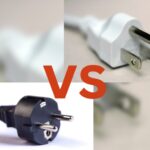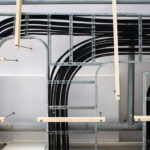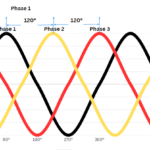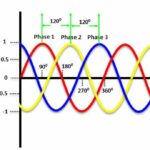208V and 220V are both standard voltages for power supply. As power demands from clients vary, so do the application of these standard voltage levels. In this article, you will learn the primary differences between 208V and 220V, common connection types, and 208V vs. 220V vs. 240V.
Transmitting 208V vs 220V
Before going into details of the differences between these standard voltages, it is necessary to establish how to attain them. Typically, power companies step up the voltage of power to minimize losses during transmission. Then, step down the voltage to the levels and the number of phases suitable for the end user’s appliances, using transformers. In North America and some parts of South America, homes mostly utilize 120VAC (110V/115V/120V) single-phase power. Moreover, two live wires of 120V each, convey this power, with most appliances making use of either of the live/hot wires. While a combination of the two live wires provides 220VAC (220V/230V/240V) single-phase, for power-heavy appliances such as electric stoves, driers, etc.
208V sees frequent use in small business commerical use in North America. Achieve this voltage, requires significant changes in electrical architecture. This is because 208V is associated with a three-phase supply. However, it is still possible to connect 208V single phase to a device from a three-phase supply. Like 220V, each hot line carries 120V, but this application requires three hot lines, plus neutral and ground wires. On the other hand, to produce 220V single phase, two hot lines and a ground make up the requirements. In any case, the voltage in each line peaks at different times, with a 120° difference between their waveforms.
So, how may the 208V requirement for end-use be met? By taking advantage of the phase difference between the lines and combining any two live wires. For a single phase, when one of the lines peaks at 120V, the other produces 88V, thus producing a combined total of 208V. For a three-phase supply, a combination of any two 120V lines gives 208V as the formula to calculate the output voltage (Vout) of the three-phase applies:
![]()
Differences between 208V and 220V
The previous section establishes that it is technically feasible to get either 208V or 220V to a device from a supply of 120V lines. Nevertheless, there are fundamental differences between 208V vs. 220V.
| 208V | 220V |
| Current flows without a neutral in a single-phase 208V circuit due to alternating voltages of the two live lines at opposite times. | Current in a 220V single phase circuit requires a grounded neutral. |
| To get 208V from two 120V lines, there should be a phase difference of 120°. | To get 220V from a 120V supply, two single-phase lines are combined. |
| 208V requires three live/hot lines for three-phase, and two live lines for single-phase. | 220V circuit requires two live/hot lines. |
| 208V is obtained only for a three-phase supply. | 220V is only from a single-phase supply. |
| Because of its three-phase, it delivers a more consistent and efficient power supply. | As a single-phase supply, it is less efficient and consistent. |
| As this requires three live lines, the amount of wiring in the circuit is more, but their diameters are smaller. | 220V wires are of thicker diameter to carry the same amount of power, but the circuit has less wiring. |
Connection Types
There are ranges of connection types to achieve various voltage requirements of end-users. This section covers some of these connections.
Single Phase Three Wire
This is the predominant residential service connection type in North America. Moreover, it is common to refer to it as an Edison system, split-phase, or center-tapped neutral. In addition, it has three wires, consisting of two live and one neutral. Thus, using a connection between any of the hot lines and the neutral powers a 120V (110V/115V/120V) single-phase load. Heavier appliances require a line 1 to line 2 connection to supply a 240V (220V/230V/240V)single-phase.
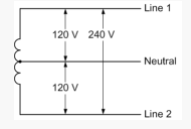
Three Phase Four Wire Wye
In North America, this three-phase configuration provides the ideal connection for commercial building electric service. Moreover, this 120/208V serves 120V loads and the 208V for smaller HVAC systems. As the diagram below shows, the connection from any live wire to neutral produces an end voltage of 120V. The higher 208V is received via phase-to-phase connections. So, in larger facilities, where lighting capacity and HVAC loads are higher, this connection can supply 277/480V. Furthermore, it is possible to push the supply up to 347/600V as is the case in Canada.
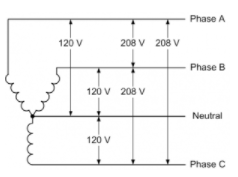
Three Phase Four Wire Delta
This high-leg or wild-leg configuration is common in older manufacturing facilities. Moreover, they are suitable for both single-phase and three-phase loads. For a single-phase load, connections occur from either phase A or C to a neutral. Three-phase loads connect to phases A, B, and C. In addition, in the case of a 120V line-to-neutral supply, the voltage between the wild leg and neutral is 208V as the diagram below shows. Thus, this configuration presents a way to attain 208V and 220V single-phase.
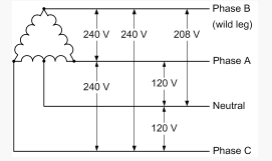
Three Phase Three Wire Delta
This is a more modern configuration than the three-phase four-wire delta that serves three-phase motor loads and utility power distribution applications. This configuration is suitable for a range of nominal service voltages such as 240V, 400V, 480V, and even higher.
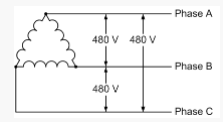
208V vs 220V vs 240V
This section outlines the differences between 208V, 220V, and 240V, which are all standard voltages for power supply.
| 208V | 220V | 240V |
| Could be single-phase or three-phase. | Is only single-phase. | Could be single-phase or three-phase. |
| Configuration has three live wires. | Configuration has two live wires. | Configuration has two live wires for single phase, and three live wires for three-phase. |
| Circuit has more wiring because of three-phase. | Circuit has less wiring. | Circuit same as 220V for single phase, but more wiring for three-phase. |
